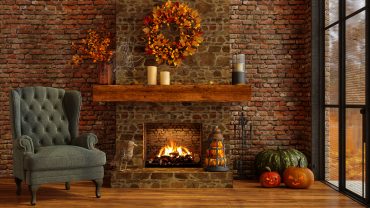Few design styles are as glamorous and iconic as Art Deco. Often referred to simply as Deco, interiors in this style are characterised by bold geometric patterns, lavish ornamentation, lacquered woods, and a penchant for exotic luxury.
The glamour, style, and sophistication of the 1920s and 1930s are intricately woven into the fabric of Art Deco interior design. This was a time of swing jazz, the golden age of Hollywood, and an unapologetic embrace of post-war modernity, all of which are reflected in the opulent and stylised designs of the period.
So, whether you want inspiration to ‘deco-rate’ your new home and infuse your space with an air of elegance, or you’re looking to bring a touch of Gatsby glamour to an uptown apartment, let’s find out the answer to the question ‘what is Art Deco interior design?’
A Short History of Art Deco Interior Design

An Art Deco-inspired dressing room (Credit: John Keeble via Getty Images)
The history of Art Deco interior decor is as colourful as the style itself. Emerging just before the start of World War I in the 1910s and reaching its apex in the 1930s, Art Deco was in part a response to the austerity imposed by the war.
Interestingly, the style didn’t get its name until 1925, with the Exposition internationale des arts décoratifs et industriels modernes, or the International Exhibition of Modern Decorative and Industrial Arts, in Paris. Arts décoratifs became Art Deco.
Art Deco emerged from the vibrant social, artistic, and cultural scene in Paris. It rapidly gained worldwide popularity, becoming the predominant style of the ‘Roaring Twenties’ and the period leading up to World War II. The era was marked by rapid industrialisation and technological advancements, which greatly influenced the design principles of Art Deco interiors as well as fashion and jewellery, and even bridges, office blocks, cinemas and ocean liners.
The style represented luxury, glamour, and a profound faith in social and technological progress, making it immensely popular among the elite and the burgeoning, upwardly mobile middle classes in Europe and America.
The Principles of Art Deco Interior Design

A typical Art Deco pattern, featuring black and gold. (Credit: oxygen via Getty Images)
What is Art Deco style interior design? Its principles are rooted in the desire to merge art with everyday life and was a radical shift away from the dark and heavy austerity of the Victorian age. It is marked by the use of symmetrical, streamlined and futuristic forms, which is a reflection of the machine age aesthetics.
Bold, clean lines, decadent detail, geometric patterns such as sunbursts, chevrons and zigzags, and stylised forms, are quintessential elements of this style. The application of exotic woods such as coromandel ebony, burl walnut and zebrano, shiny metals, and luxurious fabrics also play a crucial role in defining its character.
As well as furniture and colour, Art Deco style interior design lighting encapsulates the spirit of the age. It’s distinguished by its angular, geometric shapes and sleek, symmetrical designs, mirroring the style’s luxury and modernity. Materials like chrome, steel and etched glass are crafted into streamlined forms. These fixtures, ranging from chandeliers to table lamps, not only illuminate but also serve as bold statement pieces, embodying the era’s glamour.
In addition, Art Deco interior decor was deeply influenced by various late nineteenth and early twentieth century movements and styles, including Cubism, Futurism and Art Nouveau, the vibrant colours of Fauvism and exotic art from the Far East, India and Persia. Egyptian art, popularised by the discovery of King Tutankhamun’s tomb in 1922, was also a strong influence, and many Deco interiors feature hieroglyphics as style motifs.
Art Deco Furniture

Art Deco interior in classic style featuring furniture such as a pink armchair and green pillow. (Credit: Ninoon via Getty Images)
The style of Art Deco furniture is big on size, sophistication and glamour, characterised by its bold, streamlined shapes and an emphasis on modern luxury.
The furniture pieces are known for their geometric forms, with clean lines and angular contours. Exotic woods, and materials like chrome, marble, glass, exuberant fabrics, and mirrored surfaces are commonly used, lending a sleek, polished look to the design. The focus is on creating a sense of opulence and comfort, while also showcasing innovation and craftsmanship.
Upholstery in luxurious fabrics like velvet and leather adds to the sense of grandeur, making Art Deco furniture not just functional but also a statement piece in any interior setting.
The Art Deco Interior Design Colour Palette

Interior of an Art Deco Interior Design dressing room. (Credit: John Keeble via Getty Images)
The colours of Deco interiors are as bold and vibrant as the style itself, embodying a sense of luxury and drama.
This palette often includes deep and intense hues such as rich blues, deep emerald greens, bold blacks, and striking reds, which are then juxtaposed with softer and more opulent shades of cream, beige, and gold. This contrast creates a visually stunning and sophisticated ambiance, reflecting the glamour and exuberance of the Art Deco era. Metallic colours, particularly gold and silver, are also a staple of Art Deco interior decor, adding a touch of glitz and further accentuating the sense of luxury.
In addition to these bold choices, Art Deco interior design can also incorporate softer pastel tones like pale pinks, light blues, and mint greens, offering a more subdued yet equally elegant aesthetic.
These lighter shades are often used in combination with darker, richer colours to provide balance and contrast, enhancing the overall visual appeal. The use of glossy finishes and mirrored surfaces amplifies these colours, creating a dynamic interplay of light and shade that is quintessentially Art Deco.
This diverse and striking colour palette allows for creative freedom in design, enabling the creation of spaces that are both timeless and modern.
The Everlasting Glamour of Art Deco Interior Design

Interior Art Deco living space, featuring greenery. (Credit: Pavel Vozmischev via Getty Images)
What is Art Deco interior design? It’s a design style that stands as a timeless testament to the luxury, innovation, optimism, and bold aesthetic sensibilities of the early twentieth century. Its unique fusion of geometric patterns, rich and vibrant colour palettes, and luxurious materials creates spaces that are not only visually stunning but also rich in historical significance.
As a design style, Art Deco interiors continue to inspire and adapt, maintaining relevance and appeal in contemporary interiors. Embracing Art Deco in modern settings is not just about recreating a bygone era, it’s about infusing spaces with a sense of glamour, elegance, and a daring spirit that transcends time.












